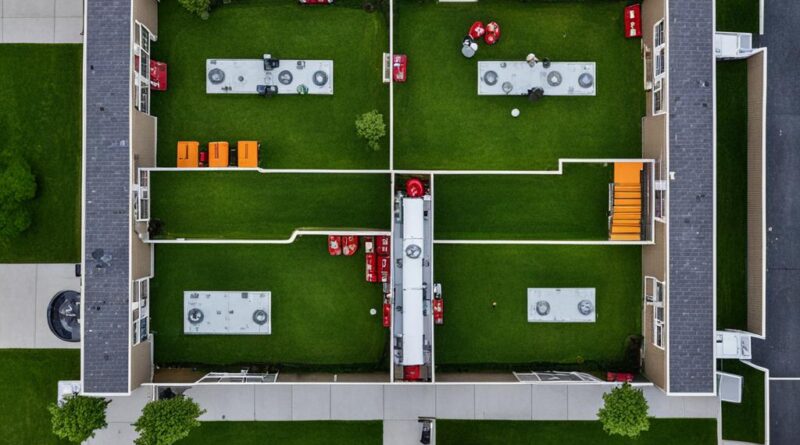Essential Guide to Fire Alarm in Apartment Safety
Navigating the layers of apartment fire safety can seem daunting, yet it’s a crucial aspect of daily living that cannot be overlooked. With the right information and tools at your disposal, safeguarding your home from fire becomes a manageable task. An effective fire alarm in an apartment is not just a mandatory fixture; it’s a lifeline that could make all the difference in a crisis. Understanding how these systems work, instituting a robust apartment fire prevention methodology, and creating a clear apartment fire evacuation plan are all essential components of a safe living environment.
In this comprehensive guide, residents will gain valuable insights into the importance of fire alarms within an apartment setting. Beyond the surface, this guide delves into practical advice on maintaining these systems, ensuring full functional readiness in the face of danger. We cover what you need to know about apartment building fire alarms—from their varied types to the intricacies of current regulations, helping you foster a fortified space against the unexpected blaze.
Key Takeaways
- Familiarize yourself with the types and functionalities of fire alarms specifically designed for apartment use.
- Implement routine maintenance checks to confirm that your apartment’s fire alarm system is in optimal condition.
- Develop and rehearse an apartment fire evacuation plan tailored to your living space’s layout.
- Learn proactive fire prevention strategies to mitigate risks of fire in your apartment.
- Understand the legalities of apartment fire safety to ensure your residence meets all necessary fire codes and standards.
Understanding Your Apartment Fire Alarm System
An apartment fire alarm system is the frontline defense in protecting residents against the dangers of fire. Having a detailed understanding of the system components and their maintenance can help ensure the safety and security of your living space. Let’s delve into the types of alarms you might find in your apartment and the significance of ongoing vigilance regarding these life-saving devices.
Types of Fire Alarms Found in Apartments
Most residential buildings are equipped with two main types of fire alarms: smoke detectors and heat detectors. Each serves its own purpose and comes with specific placement recommendations to optimize their efficiency in detecting various signs of fire.
Interconnected Smoke Alarms: Enhanced Safety Post-2009
Spearheading advancements in fire safety, modern interconnected smoke alarms represent a leap forward in protecting residents. These devices are designed to communicate with one another, ensuring that when one alarm detects smoke, all alarms simultaneously alert, offering vital time to evacuate safely.
The Role of Heat Detectors in Fire Safety
Alongside smoke alarms, heat detectors provide a complementary layer of safety, particularly suited for areas prone to rapid temperature rises, like kitchens or utility rooms. Their activation does not rely on smoke particles, allowing them to alarm in situations where smoke detectors may not respond as effectively.
Fire alarm maintenance in apartments is not just a suggestion, but a necessity. Regular checks and timely interventions can make all the difference when it comes to preventing fire incidents.
| Alarm Type | Location | Maintenance Tips | Recommended Action |
|---|---|---|---|
| Smoke Detectors | Bedrooms, Living Rooms, Hallways | Monthly testing, Annual battery replacement | Install interconnected systems for older apartments |
| Heat Detectors | Kitchens, Garages | Semi-annual testing, Clean regularly to prevent dust build-up | Ensure proper placement away from cooking appliances |
The Importance of Regular Fire Alarm Maintenance
Meticulous attention to fire alarm maintenance in apartments is not just a regulatory compliance but a cornerstone of resident safety. Ensuring the seamless operation of fire alarms through smoke detector checks and sprinkler system maintenance is a responsibility shared by apartment managers and residents alike. A robust maintenance plan can mean the difference between timely alerts and catastrophic outcomes during fire emergencies.
Scheduled Smoke Detector Checks
To keep residents safe and secure, a systematic approach to smoke detector examination must be embraced. Routine smoke detector checks should be ingrained in the building’s safety protocol with professionals conducting thorough inspections to uncover any potential malfunctions before they evolve into pressing hazards. These preventative measures ensure the detectors’ functionality, which can be life-saving in the event of an actual fire.
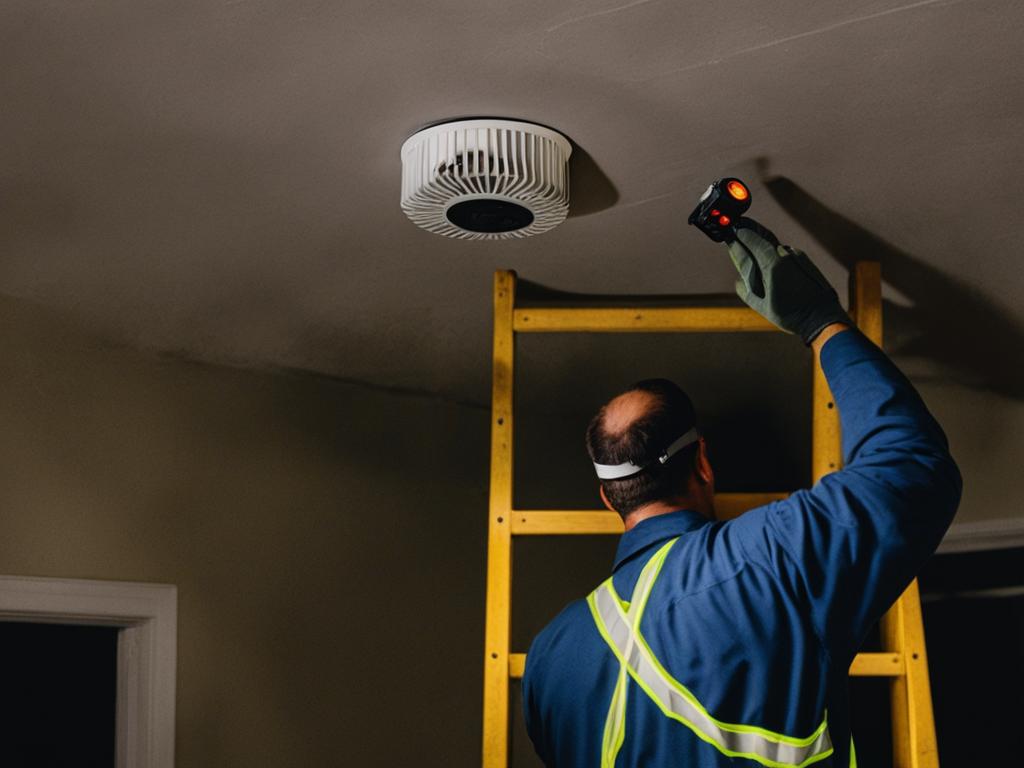
Battery Replacement Rituals for Optimal Performance
Timely battery replacements are integral to detector reliability. A useful tip for residents to remember is to align battery changes with seasonal time changes such as daylight saving time. This biannual ritual guarantees that detectors are powered and capable of performing at peak levels year-round, solidifying the layers of safety within the living space.
Upkeeping Sprinkler Systems in Apartment Complexes
The role of sprinkler system maintenance in fire suppression cannot be overstated. Regular assessments and repairs of the apartment complex’s sprinkler systems mitigate the escalation of fire incidents, providing a critical buffer in times of accidental fires. This form of active prevention, by preserving the infrastructural integrity of the building’s firefighting systems, forms an essential part of the overall fire strategy.
In essence, committing to diligent maintenance practices for fire safety equipment is a testament to the value placed on life, property, and peace of mind. By fostering a culture of regular audit and repair, apartment complexes position themselves as exemplars of fire readiness and responsibility.
Fire Evacuation Plans for Apartment Dwellers
When flames threaten the sanctity of an apartment complex, having a robust apartment fire evacuation plan is not just beneficial; it’s a lifesaving imperative. Establishing a safe exit strategy as a resident involves far more than recognizing a pathway—it’s about comprehending and executing a plan that could mean the difference between danger and safety.
Designing a Safe Exit Strategy
Effective escape planning begins long before a crisis emerges. Assessing the layout of your living space and identifying clear and unobstructed paths for escape routes should be paramount in any evacuation strategy. The plan should be practical, straightforward to follow, and regularly rehearsed to assure prompt and orderly evacuation.
Identifying Primary and Secondary Escape Routes
Understanding your primary escape route is crucial, but it’s equally important to have an alternative path. Should your main route become impassable, knowing your secondary options can be the critical difference in emerging safely. Regularly inspect these pathways, ensuring they remain clear of obstructions, and are well-lit, accessible, and understood by all members of the household.
- Primary Routes: Doors leading directly outside or to stairwells.
- Secondary Routes: Fire escapes or alternate staircases.
Coordinating a Safe Meeting Point Post-Evacuation
Once an apartment complex is evacuated, meeting point coordination is essential to account for all residents and ensure everyone’s safety. Choose a location far enough from the building to be safe, yet close enough to be reachable by all. This designated area should be communicated and agreed upon by all residents within the complex.
- Accessible location for all residents.
- Avoid proximity to traffic and other potential hazards.
- Consider special needs of residents, including pets.
Adhering to Apartment Fire Alarm Requirements
In ensuring the safety of apartment residents, strict adherence to fire alarm requirements is a critical aspect of property management and residency. Meeting these requirements not only protects residents but also aligns with the law. Let’s delve into the legal expectations and specifications to better understand the importance of fire safety systems in apartment living.
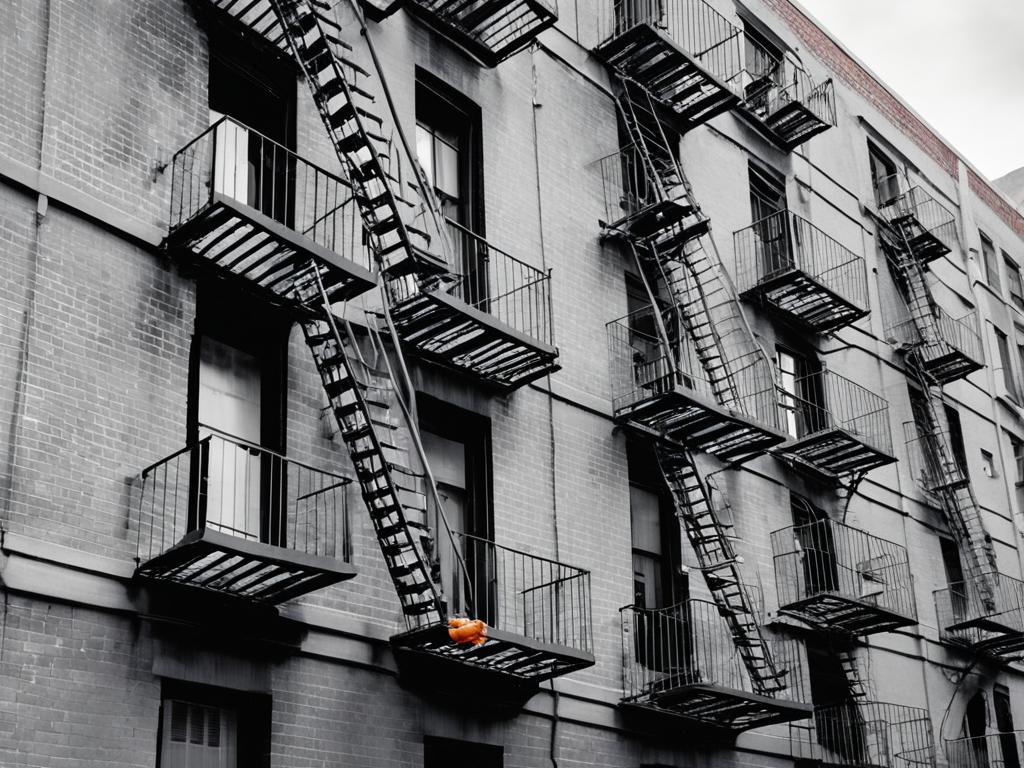
Legal Obligations for Apartment Fire Safety
The legal framework governing fire safety in apartments establishes the minimum standards required for resident protection. These mandate the presence and maintenance of fire detection and notification systems to quickly alert residents of potential danger, thus providing time to evacuate in case of emergency. Regular inspections and compliance checks are integral to adhering to these legal obligations for fire safety.
Required Number of Detectors per Apartment
When it comes to apartment fire alarm requirements, the number and type of detectors in each unit can vary depending on the size and layout of the apartment. These stipulations ensure that no area within a residence is left unprotected, thereby drastically reducing the risk of undetected fire incidents.
| Apartment Size | Smoke Detectors | Heat Detectors | Combined Devices |
|---|---|---|---|
| Studio/1-Bedroom | 1-2 | 1 | Optional |
| 2-Bedroom | 2-3 | 1-2 | Optional |
| 3-Bedroom | 3-4 | 2 | 1 |
| Larger Apartments | Varies | Varies | At least 1 |
Compliance with Building Fire Safety Codes
Apartments are also legally required to comply with building fire safety codes, which are regional ordinances designed to standardize protection against fires. These codes dictate construction materials, means of egress, and the integration of fire suppression systems, contributing to a holistic approach to safety in multi-family housing developments.
- Regular inspections for code compliance
- Up to date firefighting systems such as sprinklers and extinguishers
- Clear and accessible escape routes
Ultimately, the responsibility for ensuring compliance with fire alarm requirements and building safety codes falls on both apartment management and residents. By understanding these obligations and working together, all parties can contribute to a safer living environment that is prepared to handle the unforeseen event of a fire.
Contributing Factors to Apartment Building Fires
Understanding the contributing factors to fire outbreaks in apartment buildings is a critical aspect of apartment fire prevention. Irresponsible behavior and overlooked safety measures can easily lead to a dangerous situation that puts lives and property at risk. Let’s delve into some of the root causes that play a substantial role in the ignition of apartment fires.
| Negligence in Handling Flammable Materials | Improper Disposal of Smoking Materials | Unsafe Electrical Practices |
|---|---|---|
| Storing flammable liquids near sources of heat or open flames | Cigarettes flicked into trash without ensuring they’re fully extinguished | Using frayed wires or overloaded power outlets |
| Failure to secure flammable items in a safe and designated area | Improper disposal of matches and lighters reachable by children | Ignoring flickering lights or electrical sparks from outlets |
| Lack of caution when using candles or other open flames | Leaving smoking materials unattended or in precarious positions | DIY electrical repairs without proper knowledge or shutdowns |
Prevention and education are key to mitigating these contributing factors. Not only should residents be vigilant in their own apartments, but they also need to be aware of common fire hazards within their community. By identifying and correcting these behaviors, apartment dwellers can significantly lower the risk of fire in their homes, demonstrating the paramount importance of proactive fire safety measures.
Fire Prevention Tips for Apartment Living
Living in an apartment comes with its unique challenges when it comes to fire safety. Implementing effective fire prevention strategies is crucial for protecting both life and property. Among the most effective strategies are safe cooking practices, proper disposal of smoking materials, and conscientious management of electrical hazards. By following these practical tips, residents can play an active role in reducing the risk of fire in their homes.
Safe Cooking Practices to Mitigate Fire Risks
Among the leading causes of home fires is cooking. To ensure safety in the kitchen, always stay alert and attentive when cooking. Here are several safe cooking practices:
- Never leave food unattended while cooking on the stove.
- Keep flammable items like dish towels and paper bags away from the stovetop.
- Regularly clean burners and ovens to prevent the build-up of grease which can ignite.
- Install a timer as a reminder that you are cooking, which is especially useful if you get called away.
Proper Disposal of Smoking Materials
Improperly disposed of smoking materials are another leading cause of residential fires. The following tips can ensure the safe disposal of smoking materials:
- Use deep, sturdy ashtrays placed away from anything that can burn.
- Before throwing out butts and ashes, douse them in water or sand to make sure they are fully extinguished.
- Never dispose of hot smoking materials in trash bins or potted plants.
- Keep lighters and matches out of reach from children to prevent accidental fires.
Managing Electrical Hazards in the Home
Electrical hazards pose significant risks in the home. Here are ways to manage these hazards effectively:
- Avoid overloading power outlets and extension cords to prevent heating and potential fires.
- Regularly inspect cords for damage and replace them if necessary; never attempt to repair them with tape.
- When plugging in appliances, make sure cords do not run under carpets or across doorways where they can get damaged.
- Engage a qualified electrician to perform any complex installations or repairs.
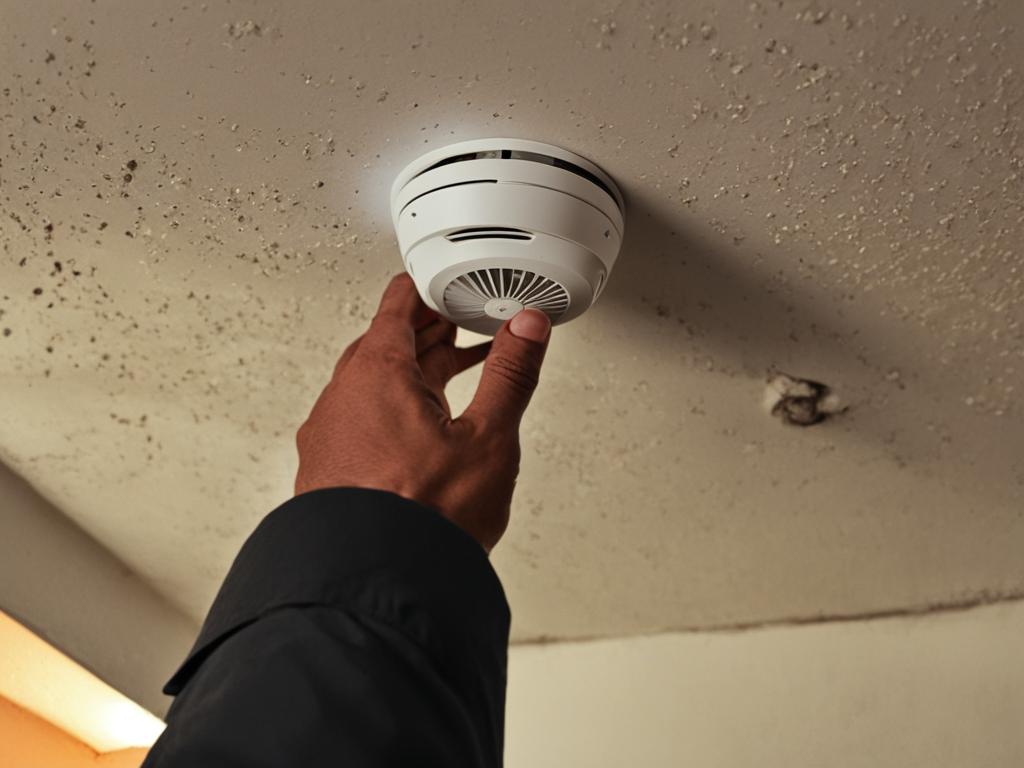
By incorporating fire prevention tips into your daily routine and staying aware of the dangers, you can significantly reduce the likelihood of fire in your apartment. Remember, effective fire prevention begins with each individual’s actions and awareness.
Apartment Residents’ Role in Fire Safety
As integral components of fire prevention and safety, residents in apartment complexes bear a significant responsibility. Keeping abreast of safety measures and ensuring operational fire alarms contributes not only to individual safety but also to the well-being of all occupants within a community.
Maintaining Your Smoke Alarm
Ensuring the functionality of a fire alarm in an apartment is the first step every resident must undertake. Regular checks and timely battery replacements can make the difference in a life-threatening situation. Here’s a helpful checklist for smoke alarm maintenance:
- Test alarms monthly using the test button.
- Replace batteries at least once a year or as recommended by the manufacturer.
- Never paint over or obstruct smoke detectors.
- Replace the entire unit every 10 years.
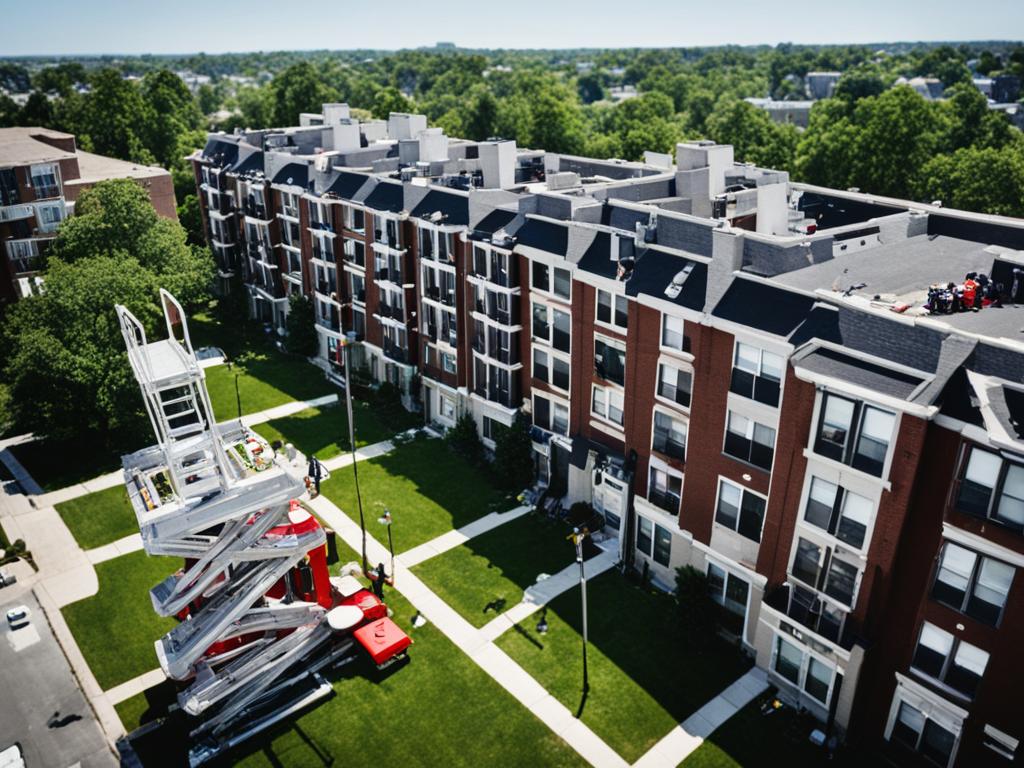
Remember, a well-maintained smoke alarm is a vigilant guardian in times of danger.
Understanding and Following Building Fire Safety Features
Apartment fire safety is as much about understanding the features of your building as it is about individual alert systems. Residents must be familiar with the fire safety plan and equipment provided in their building:
| Fire Safety Feature | Description | Resident’s Action |
|---|---|---|
| Sprinkler Systems | Automatically activated by high heat levels to extinguish or control fires. | Ensure sprinklers are unobstructed and report damages immediately to maintenance. |
| Fire Extinguishers | Portable devices placed throughout the building for small fires. | Familiarize yourself with their locations and learn how to use them properly. |
| Emergency Exits | Designated egress routes clearly marked and easily accessible. | Regularly locate and remember the paths to these exits. |
| Fire Doors | Doors designed to stop the spread of fire and smoke between compartments. | Keep fire doors closed and never prop open. |
Raising Awareness Among Neighbors
By raising neighbor fire safety awareness, you build a community capable of collectively responding to emergencies.
Engaging in dialogue with neighbors, participating in community safety meetings, and conducting informal peer training sessions are practical ways to enhance the collective knowledge and preparedness of the resident community. Perpetuating a culture where safety is everyone’s business reduces risks and underscores the shared nature of apartment living.
Innovations in Fire Alarm Technology for Apartments
The evolution of fire alarm technology has opened up new frontiers for apartment safety. With innovations in fire alarm technology, the level of interconnectivity and intelligence in these systems has reached unprecedented heights. Smart fire alarm solutions are now the norm, rather than the exception, heralding a new era of protection for apartment residents.
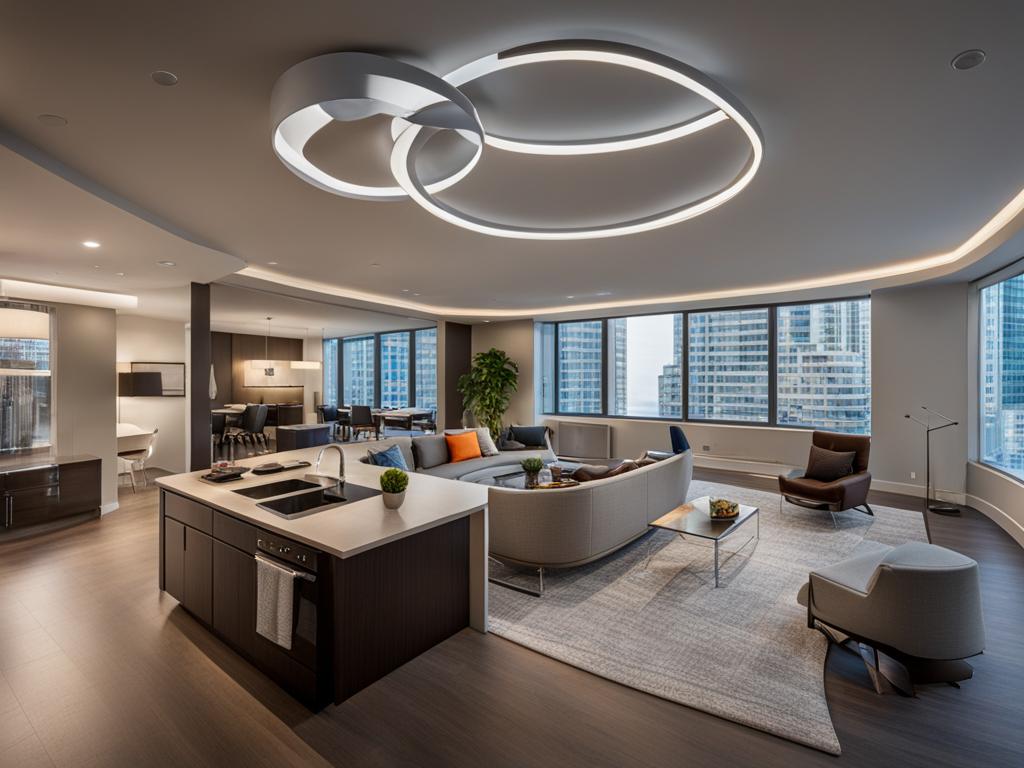
These technological advancements pave the way for seamless integration with home automation systems, making it possible for real-time alerts to be sent directly to residents’ smartphones or central monitoring services. This integration ensures that even when residents are away from home, they are immediately aware of potential dangers, allowing for a quicker response to prevent damage or escalation.
Take a closer look at some of the cutting-edge features that today’s fire alarm systems boast:
- Remote monitoring and control for enhanced vigilance
- Advanced smoke detection capabilities to identify fire signatures faster
- Automatic self-testing ensuring devices are always operational
- Integrated CO detectors for all-in-one hazard detection
These smart solutions also contribute to more efficient maintenance protocols. Gone are the days of manual checks as systems can now notify you when a battery is low or when a sensor malfunctions.
| Feature | Benefits |
|---|---|
| Wireless Connectivity | Eliminates the need for extensive wiring, making installation and maintenance simpler |
| Smartphone Integration | Allows for immediate notification and remote system management |
| Interconnected Alarms | Ensures that when one alarm is triggered, all alarms sound throughout the apartment |
| Home Automation Compatibility | Facilitates interaction with other smart home devices for an all-encompassing safety approach |
In summary, innovations in fire alarm technology have significantly bolstered the safety features available to apartment dwellers. As these systems continue to integrate with broader smart home technologies, their potential to save lives and protect property grows exponentially. We are witnessing a reassuring shift towards a future where apartments are not only smarter but safer.
A Step-by-Step Guide to Responding to Apartment Fires
When a fire breaks out in your apartment complex, knowing the right fire response plan and fire alarm steps can make all the difference. The following guide presents a systematic approach to enhance apartment fire safety and ensure a well-coordinated reaction to such perilous situations.
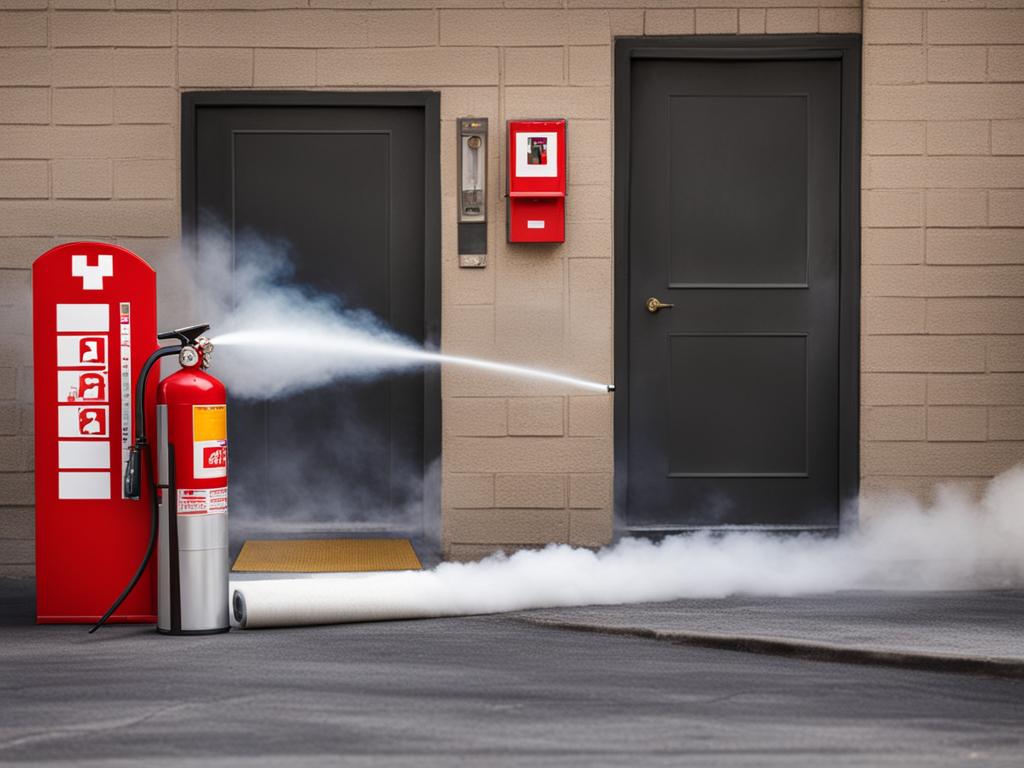
- Identifying the Alarm: Recognize the sound of your building’s fire alarm and determine its location.
- Immediate Action: If the alarm is in your unit, check for fire or smoke before opening doors or windows.
- Fire Evacuation Plan: Proceed with your pre-planned evacuation route, using stairs instead of elevators.
- Alert Authorities: Call 911 or your local emergency number as soon as it is safe to do so.
- Assist Others: Help neighbors if possible, especially the elderly or those with disabilities.
- Evacuation: Leave the building quickly and calmly, heading to the designated meeting area.
Each step should be executed with precision and clarity to ensure not just your safety, but the safety of all residents.
| Step | Action | Details |
|---|---|---|
| 1 | Alarm Identification | Quickly locate the source and type of the alarm. |
| 2 | Initial Safety Check | Check for signs of fire or smoke in your vicinity. |
| 3 | Evacuation Preparation | Gather essentials and prepare to leave immediately. |
| 4 | Contact Emergency Services | Call for help using the nearest safe phone line or cell phone. |
| 5 | Assistance to Others | Offer help to fellow residents while evacuating. |
| 6 | Safe & Orderly Evacuation | Head to the meeting point avoiding elevators and ensuring to close doors behind you. |
Remember to always stay informed of your apartment complex’s specific fire response plan and tailor these steps accordingly. Staying prepared is the keystone of apartment fire safety. For more in-depth information, refer to the complete fire safety manual provided by your building’s management.
Integrating Fire Alarms with Home Security Systems
In the realm of apartment safety, the integration of an apartment fire alarm system with home security systems is transforming how residents safeguard their homes from potential dangers. This integration not only promises enhanced fire detection but also an amalgamation of security features that manage intrusion detection, creating a cohesive protection environment.
Integrating Alarms with Home Security Systems for Enhanced Protection
Home security systems integration with fire alarms enables a unified system where alerts can be received for both fire and security breaches. Such systems create a nexus of protection that assures peace of mind for apartment dwellers. This seamlessness in protection is made possible by high-tech sensors and alarms that communicate with a central hub, ensuring constant vigilance.
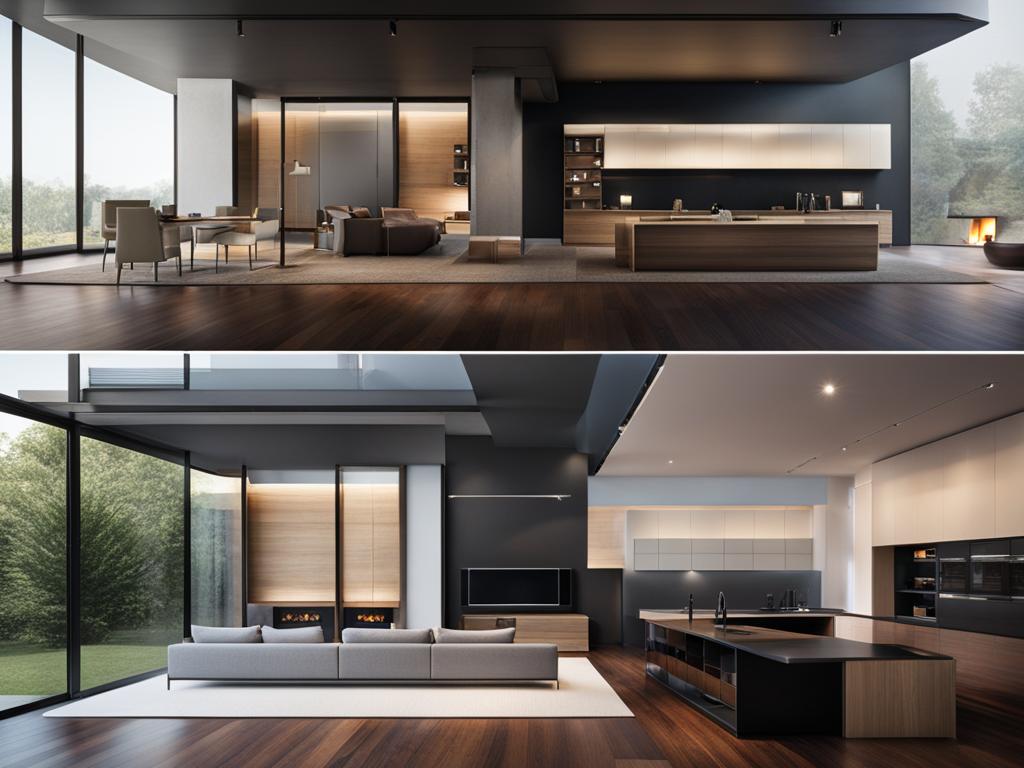
Monitored versus Unmonitored Fire Alarm Options
When selecting a fire alarm, the decision between a monitored fire alarm and an unmonitored system can be pivotal. Monitored solutions are backed by 24/7 surveillance centers that immediately dispatch emergency services in the event of a fire, whereas unmonitored systems depend on the local alarm’s ability to alert residents on-site.
| Feature | Monitored Fire Alarm | Unmonitored Fire Alarm |
|---|---|---|
| 24/7 Surveillance | Yes | No |
| Connectivity | Central monitoring center | Local siren or alarm |
| Emergency Dispatch | Automatic | Manual |
| Monthly Fee | Yes | No |
The Advantages of Smart Fire Alarm Solutions
The evolution of the traditional fire alarm system has given way to the emergence of smart fire alarm advantages. These state-of-the-art devices epitomize convenience with features such as remote monitoring and control via smartphones. Residents can receive real-time updates, silence false alarms, and even integrate them with other smart home devices for a truly automated home safety experience.
- Remote alerts and notifications
- Compatibility with smart home devices
- User-friendly interfaces and controls
Training and Drills: Preparing for Emergencies
Preparing for fire emergencies in apartment buildings is not just about installing the right equipment; it involves engaging residents through regular fire emergency drills and effective fire alarm communication. These practices ensure that residents are not only aware of the procedures but are also proficient in executing them swiftly and safely during an actual emergency.
The Need for Regular Fire Emergency Drills in Apartment Buildings
The most effective way to prepare residents for a fire emergency is through regular, structured drills. These drills serve as a practical means for rehearsing quick and orderly evacuations, helping to engrain the right responses during tense situations. Moreover, drills reinforce the importance of fire safety and encourage an overall state of readiness among the apartment community.
Effective Communication During Fire Alarms
When the fire alarm sounds, clear and effective communication is vital. It is essential for property managers and safety officers to disseminate timely information about the fire’s location and the best evacuation routes. This clarity can be the difference between a successful evacuation and one that results in chaos and confusion.
Educational Resources for Ensuring Tenant Compliance
Educational tools and resources are the backbone of any fire safety strategy. By providing accessible fire safety educational resources, apartment buildings can ensure that their residents have the knowledge required to comply with safety protocols. These resources should be updated regularly to reflect any changes in fire safety standards or evacuation procedures.
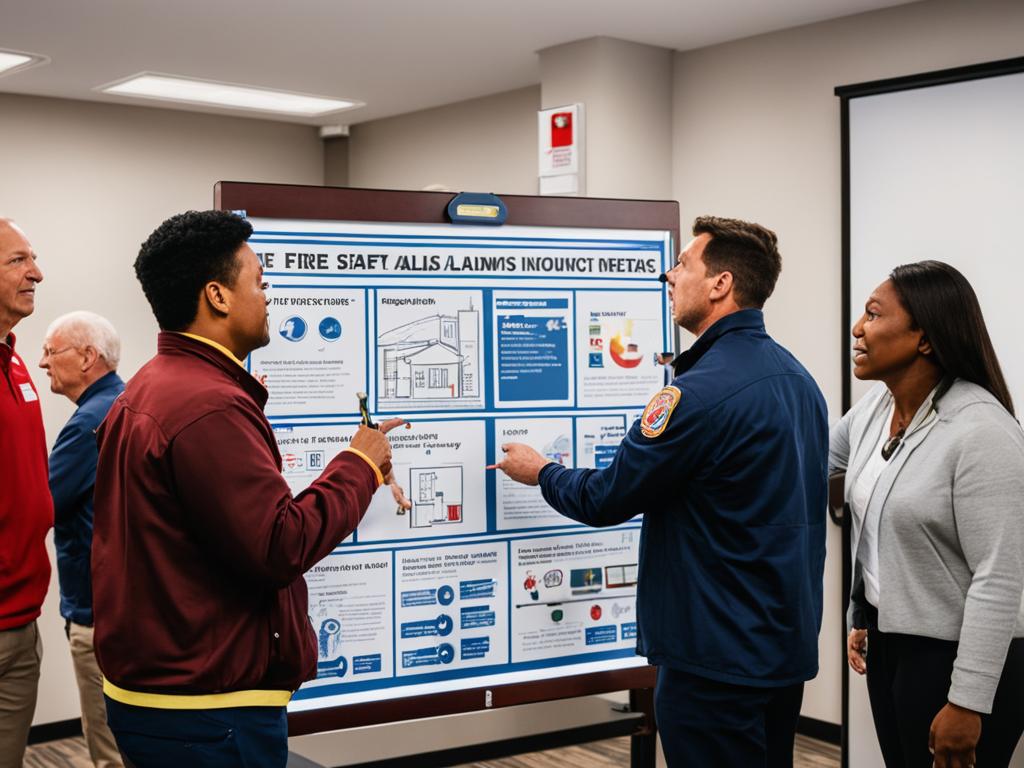
| Resource Type | Purpose | Delivery Method |
|---|---|---|
| In-person Training Sessions | To walk residents through the steps of a fire emergency response | Community Meeting Rooms |
| Printed Guides & Flyers | To provide quick reference materials that can be kept in each apartment | Lobby Areas and Mailboxes |
| Digital Tools & Apps | To offer interactive learning experiences and real-time alerts | Online Platforms & Mobile Devices |
| Safety Signage | To remind residents of key fire safety practices and evacuation routes | Strategically placed throughout the building |
Conclusion
Fostering a safe and secure living environment hinges on the rigorous application of fire alarm safety essentials within apartment complexes. Every resident’s understanding of fire alarms, habitual maintenance, and compliance with fire legislation forms the backdrop against which the battle for fire safety is waged. The collective wisdom gleaned over years is encapsulated in this guide, serving not only as a resource for current apartment dwellers but also as a beacon for continuous improvement in fire safety measures.
Summarizing the Essence of Fire Alarm Safety in Apartment Living
To encapsulate fire alarm safety in apartment living, it is vital to recognize that it rests on the pillars of knowledge, regular system maintenance, and adherence to established safety protocols. The integrity of individual safety, as well as that of the larger community, relies on each resident’s commitment to these guiding principles. Ingrained vigilance and proactive behaviors significantly diminish the potential threats posed by fires, ensuring that tranquility and well-being are maintained within apartment enclosures.
Continual Improvement of Fire Safety Measures in Apartments
As technology advances and new safety strategies emerge, there is an ongoing need for the improvement of fire safety measures within apartment contexts. Persistent enhancement of systems and practices, coupled with the evolution of safety protocols, guarantees that residents are shielded by the most effective defense against fire hazards. It is our collective responsibility to embrace these advancements and support a culture of relentless improvement, ultimately creating an even safer tomorrow for all apartment inhabitants.
FAQ
What types of fire alarms are commonly found in apartments?
Apartments typically feature a range of fire alarms, including smoke detectors and heat detectors. These devices may be standalone or interconnected within the apartment complex.
How do interconnected smoke alarms enhance safety in post-2009 buildings?
Interconnected smoke alarms in buildings constructed after 2009 can simultaneously alert the entire unit when one alarm is triggered, providing an early warning and more time to evacuate in case of fire.
What role do heat detectors play in apartment fire safety?
Heat detectors are important in apartment fire safety as they detect rapid rises in temperature. They are ideal in environments that can become hot and are less prone to false alarms compared to smoke detectors.
How often should I check my smoke detector and replace its batteries?
Smoke detectors should be checked regularly, and it’s recommended to replace the batteries at least once a year or according to the manufacturer’s instructions. A good practice is to replace batteries during daylight saving time adjustments as a reminder.
Why is it important to maintain the sprinkler systems in my apartment complex?
Maintaining sprinkler systems is crucial as they can control and often extinguish a fire before it becomes widespread, reducing damage to the property and saving lives.
What elements are vital when designing a fire evacuation plan for an apartment?
A comprehensive fire evacuation plan should include a safe exit strategy, clear identification of primary and secondary escape routes, and a predefined meeting point for residents to gather after evacuation.
What are the legal obligations for apartment fire safety?
Legal obligations for apartment fire safety typically include installing an adequate number of smoke and heat detectors per apartment unit and ensuring that the building complies with local fire safety codes and regulations.
What contributing factors can lead to fire outbreaks in apartment buildings?
Fire outbreaks in apartment buildings can result from neglectful handling of flammable materials, improper disposal of smoking materials, unsafe cooking practices, and poor electrical safety, among other factors.
What fire prevention tips should I follow in my apartment?
To prevent fires in your apartment, practice safe cooking habits, dispose of smoking materials properly, keep matches out of children’s reach, and ensure that electrical outlets are not overloaded and cords are kept in good condition.
As a resident, how can I contribute to fire safety in my apartment complex?
You can maintain your smoke alarms, stay informed about your building’s fire safety features, adhere to fire evacuation plans, and raise awareness among your neighbors about fire safety practices.
What innovations in fire alarm technology are beneficial for apartments?
Innovations in fire alarm technology for apartments include interconnected alarms, smart solutions that can automatically notify residents and emergency services, and integration with home automation for enhanced monitoring and control.
How do smart fire alarm solutions enhance apartment safety?
Smart fire alarm solutions enhance apartment safety by providing features such as remote monitoring and control, which allow residents to receive alerts on their devices and take action, even when they are not physically present.
What are the advantages of integrating fire alarms with home security systems?
Integrating fire alarms with home security systems provides an all-encompassing safety approach by combining fire detection with intrusion detection and may include options for professional monitoring and automatic dispatch in emergencies.
Why are regular fire emergency drills important in apartment buildings?
Conducting regular fire emergency drills helps residents become familiar with evacuation procedures, ensuring that they can exit the building quickly and calmly in the event of an actual fire.
How can effective communication during fire alarms improve safety?
Effective communication during fire alarms ensures that all residents are informed about the danger and understand the steps they need to take to evacuate safely, reducing the risk of injury or confusion.
What role do educational resources play in fire safety and ensuring tenant compliance?
Educational resources, such as guides and instructional materials, provide tenants with the knowledge and skills they need to prevent fires and respond appropriately during emergencies, fostering a community of compliance and safety awareness.
How can apartment living safety be continually improved with regard to fire alarms?
Continuous improvement can be achieved by staying up-to-date with the latest fire safety technologies, regularly maintaining and testing fire alarm systems, and providing ongoing education and drills for residents to ensure everyone is prepared for fire emergencies.

